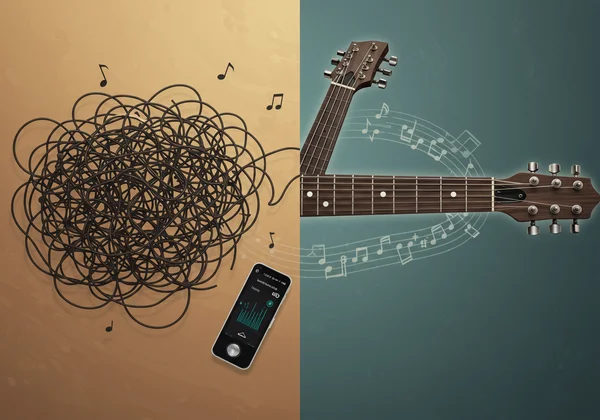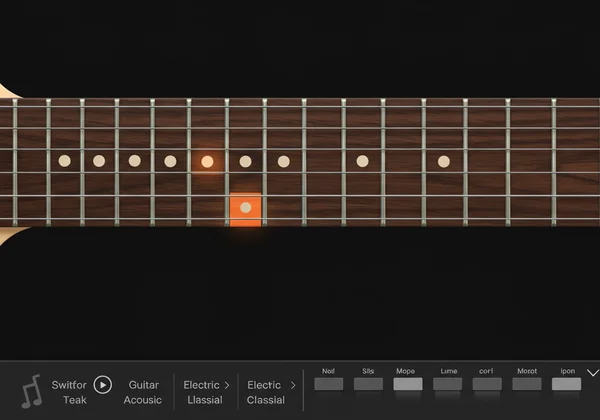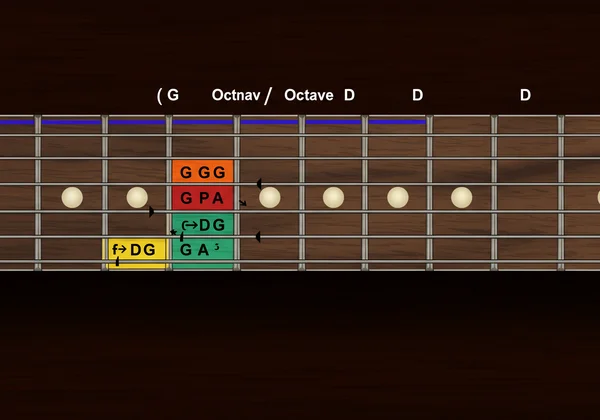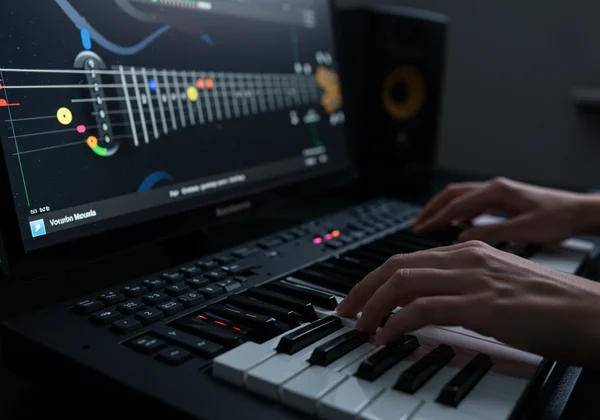Master Guitar Fretboard Notes with Virtual Guitar
Learning to play the guitar is an exciting journey, but many aspiring musicians hit a common roadblock: the fretboard. That grid of strings and frets can seem like a complex, indecipherable map. But what if you could unlock it, turning confusion into confidence? This guide, powered by our virtual guitar, is designed to do just that. We'll demystify the fretboard, providing you with a clear, step-by-step method to learn and memorize every note. How can you learn all the notes without getting overwhelmed? By using an interactive tool that makes practice accessible and fun.
The knowledge of the fretboard is the foundation of everything you will ever play, from your first chord to your most intricate solo. It separates guessing from knowing, allowing you to navigate the instrument with intention and creativity. With our free, no-download tool, you can start building this crucial skill right now. Let's begin your journey to fretboard mastery and unlock your potential.

Understanding Your Guitar Fretboard Notes
Before you can master the fretboard, you need to understand its basic components. A guitar fretboard is a visual representation of musical pitch. Each string has a different starting note (when played "open"), and each fret you press raises that note's pitch by one half-step. Our online guitar makes visualizing this simple and intuitive.
Think of it as a grid. The horizontal lines are the strings, and the vertical lines are the frets. Your job is to learn the name of the note at every intersection of this grid. It sounds daunting, but with the right system and a great practice tool, it's entirely achievable.
The Anatomy of the Virtual Guitar Interface
First, let's get familiar with your new practice space. When you visit our virtual guitar website, you are greeted with a large, interactive fretboard. You'll see six strings, typically tuned from thickest to thinnest (lowest pitch to highest) as E, A, D, G, B, and a high E. You can click on any string at any fret to hear the note, or even better, use your computer keyboard for a more tactile experience. Notice how you can switch between different guitar sounds, like acoustic, electric, and classical. For now, just focus on the layout—this is your interactive map to explore the fretboard.

Open Strings and the Musical Alphabet
The key to learning the fretboard starts with two things: the notes of the open strings and the musical alphabet. The standard tuning for a guitar is E-A-D-G-B-E. A popular mnemonic to remember this is "Eddie Ate Dynamite, Good Bye Eddie." Say it a few times while looking at the strings on our virtual instrument.
Music uses a 12-note alphabet that repeats: A, A♯/B♭, B, C, C♯/D♭, D, D♯/E♭, E, F, F♯/G♭, G, G♯/A♭. The '♯' (sharp) means one fret higher, and '♭' (flat) means one fret lower. Notice that there are no sharps or flats between B and C, or between E and F. This simple rule will save you hours of confusion! Once you know this sequence, you can find any note on any string, starting from the open string note.
How to Learn Notes on Guitar Systematically
Randomly trying to memorize all 100+ notes on the fretboard is inefficient. The secret is a systematic, string-by-string approach combined with pattern recognition. This breaks the task into small, manageable chunks and helps your brain build a mental map of the instrument. The goal isn't just memorization; it's instant recall.
This methodical practice builds a strong foundation, making it easier to understand chords, scales, and music theory later on. Using our online guitar for this process provides immediate auditory feedback, reinforcing what you're learning visually. Begin your practice and see how quickly you can make progress with a structured plan.
Mastering Each String: E, A, D, G, B, e
Focus on one string at a time. Let’s start with the thickest string, the low E string.
- Play it open: You hear an E.
- Press the 1st fret: That's an F (remember, no sharp between E and F).
- Press the 2nd fret: That's an F♯.
- Press the 3rd fret: That's a G. Continue up the string, naming each note as you play it on our online guitar simulator. Go all the way to the 12th fret, which will be an E again, one octave higher than the open string. Do this for a few minutes. Then, test yourself: try to find a specific note, like an 'A' (5th fret) or a 'C' (8th fret). Once you feel comfortable with the E string, move on to the A string and repeat the entire process.
The Power of Octaves and Patterns
Once you start learning the notes on different strings, you'll begin to see patterns. The most useful pattern for finding your way around is the octave shape. An octave is the same note at a higher or lower pitch. Finding these shapes will dramatically speed up your learning process.
For example, find the note 'G' on the 3rd fret of your low E string. You can find the same 'G' note two strings higher and two frets up—on the 5th fret of the D string. This two-strings-over, two-frets-up pattern works for most of the fretboard. Use our virtual tool to find a note on the E or A string, then use the octave shape to find its counterpart. This is a powerful shortcut that will revolutionize how you see the neck.

Practice & Test Your Knowledge with Virtual Guitar Notes
Theory is important, but practical application is where real learning happens. You need to actively test your recall in a low-pressure environment. That's where our platform truly shines. It's not just a passive chart; it’s an interactive playground designed to make practice effective and engaging.
By turning learning into a game—"Can I find all the 'D' notes in 30 seconds?"—you build muscle memory and neural pathways much faster. The instant feedback of hearing the correct pitch confirms your knowledge and makes the process enjoyable.
Interactive Drills on VirtualGuitar.org
Here are some simple drills you can start right now. Open our free online guitar and try these challenges:
- Horizontal Drill: Pick one string (like the G string) and play every note from the open string to the 12th fret, saying the name of each note out loud.
- Vertical Drill: Pick one fret (like the 5th fret) and play the note on each of the six strings, naming them all (A, D, G, C, E, A).
- Note Finding Drill: Pick one note, like 'C', and try to find it on every string. Hear how the pitch changes but the note name remains the same.
Keyboard Mapping for Quicker Fretboard Recall
To make practice even more efficient, our tool allows you to play guitar on keyboard. Instead of clicking with a mouse, you can map rows of your computer keyboard to the guitar strings. This provides a more fluid and musical experience, allowing you to move between notes faster and build a stronger connection between your brain and your fingers. This feature is perfect for practicing scales or quickly jumping between different notes for recall drills. It transforms a simple web tool into a responsive instrument for learning.

Unlock More: Basic Music Theory Guitar & Beyond
Why is it so important to learn the notes on the fretboard? Because it’s the key that unlocks the entire world of music. Knowing your notes transforms you from someone who just copies chord shapes into a musician who understands why those chords work. It's the first and most critical step in understanding basic music theory guitar.
This knowledge is your ticket to creative freedom. It allows you to build chords, create melodies, improvise solos, and communicate with other musicians in a universal language.
The Foundation for Scales and Solos
Similarly, scales are nothing more than organized sequences of notes. The C major scale, for instance, contains the notes C, D, E, F, G, A, and B. If you want to play a solo or write a melody in the key of C, you need to know where to find those notes quickly. Mastering the fretboard gives you a complete map of all your available notes, allowing you to play with freedom and confidence. It's the essential foundation for learning guitar scales online and expressing your musical ideas.
The guitar fretboard doesn't have to be a mystery. By breaking it down into manageable steps and using the right tools, you can systematically build the knowledge that will empower all of your future playing. Knowing the notes is the ultimate musical superpower, giving you the freedom to play what you feel and understand the music you love.
There's no need to wait for the perfect time or buy expensive equipment. You have everything you need to start right now. This guide has given you the map, and our virtual guitar tool is the interactive vehicle for your journey. Don't just read about it—do it. Visit VirtualGuitar.org, choose your favorite guitar sound, and start finding those notes. Share your progress or any questions you have in the comments below!
Frequently Asked Questions About Learning Guitar Notes Online
How can I play guitar online with my keyboard to find notes?
On our platform, the interactive tool includes a keyboard mapping feature. This allows you to assign specific keys on your computer keyboard to play notes on the virtual strings. This is an incredibly effective way to practice finding notes quickly, as it's much faster and more intuitive than using a mouse. Simply load the page and follow the on-screen guide to start playing instantly.
Is VirtualGuitar.org the best virtual guitar website for learning the fretboard?
While "best" is subjective, our tool is designed specifically to be an exceptional learning tool. We offer multiple realistic guitar tones (acoustic, electric, classical), a clean and responsive interface, and seamless keyboard mapping—all completely free and without any downloads. Our focus on providing an interactive and accessible platform makes it an ideal choice for anyone looking to master our virtual fretboard.
Can I truly learn guitar online for free, starting with notes?
Absolutely. Learning the notes on the fretboard is a knowledge-based skill, and our platform gives you the perfect environment to acquire that knowledge for free. By combining our tool with guides like this one, you can build a solid musical foundation without spending any money. The key is consistent practice, which our tool makes easy and enjoyable.
How long does it take to memorize all guitar fretboard notes?
This varies for everyone, but with consistent daily practice of 15-20 minutes using the systematic methods described above, most learners can become quite comfortable with the entire fretboard in a few weeks to a couple of months. The goal is not just speed but accuracy. Using an interactive tool like ours can accelerate the process by making practice sessions more efficient and engaging.